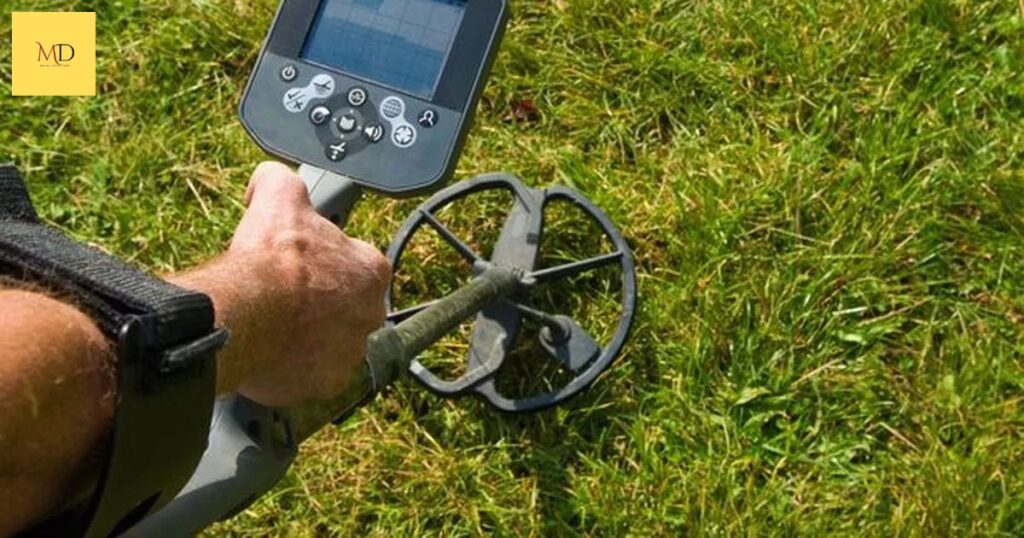A metal detector is a device that detects the presence of metal objects. It emits electromagnetic fields and detects changes in them when metal is nearby. Commonly used for security and treasure hunting, metal detectors come in various sizes and types. They are essential tools for finding buried coins, relics, or even ensuring safety in public places.
Unlock the exciting world of treasure hunting with a Bounty Hunter metal detector! If you’ve ever wondered how to use a Bounty Hunter metal detector, this guide will walk you through the essential steps, so you can embark on your own treasure-hunting adventure today. Start discovering hidden gems and precious artifacts by mastering the art of using a Bounty Hunter metal detector.
Learning how to use a Bounty Hunter metal detector is the key to uncovering hidden treasures underground. These detectors are user-friendly and come with detailed manuals. Simply follow the instructions to set up your device, sweep it over the ground, and listen for signals that indicate metal objects. With practice, you’ll become a pro at finding coins, relics, and other exciting discoveries.
Getting Started with Your Bounty Hunter Metal Detector
Getting started with your Bounty Hunter metal detector is an essential first step in your treasure-hunting journey. Once you’ve unboxed your detector, take a moment to familiarize yourself with its components. Most Bounty Hunter models consist of a coil, a shaft, a control box with a display, and an armrest. Properly assembling these parts ensures that your detector is ready for action.
To configure your detector for use, start by connecting the coil securely to the lower end of the shaft. Adjust the shaft length to a comfortable height, ensuring that it’s suitable for your height and posture. You can also customize the armrest and handle to achieve the most ergonomic and balanced grip. Once you’ve completed these setup steps, you’re well on your way to exploring the world of metal detection and uncovering hidden treasures beneath the earth’s surface.
Setting Up Your Detector
Setting up your metal detector is a crucial step in the treasure-hunting process. It ensures that your Bounty Hunter detector functions optimally and accurately detects metal objects. The setup typically involves assembling the detector, which includes connecting the search coil, adjusting the shaft length, and configuring the armrest and handle to suit your comfort. These steps are essential for achieving an ergonomic and effective detecting experience.
Understanding how to set up your detector’s control panel, including sensitivity and discrimination settings, allows you to fine-tune the device to your specific needs and the terrain you’re searching. Getting this right ensures that you’ll be more efficient in identifying valuable targets and minimizing false signals. Once you’ve mastered the setup, you’ll be well on your way to a successful treasure-hunting adventure, ready to explore the world beneath your feet with confidence.
Understanding the Display and Controls
Understanding the display and controls of your Bounty Hunter metal detector is a crucial step in becoming a proficient treasure hunter. The display panel serves as your guide to what’s happening beneath the surface. It provides valuable information about the type of metal detected, signal strength, and other essential data. Familiarizing yourself with the controls is equally important, as they allow you to fine-tune your detector’s settings.
You can adjust sensitivity to match the specific terrain, discriminate against certain types of metals, and control the volume of audio signals. By mastering the display and controls, you’ll be better equipped to interpret signals, differentiate between trash and treasure, and optimize your metal-detecting experience. It’s a skill that can make the difference between a successful outing and a frustrating one, as you uncover valuable artifacts and enjoy the thrill of the hunt.
Detecting Metal

Detecting metal is the fundamental purpose of a metal detector. These devices work by emitting electromagnetic fields and analyzing the changes in those fields when they encounter metal objects. When a metal detector is swept over an area, it can detect various types of metals, such as coins, jewelry, relics, or even buried artifacts. As the detector passes over a metal target, it generates an audible or visual signal to alert the user, making it a valuable tool for treasure hunters, security personnel, and hobbyists.
The art of detecting metal involves not only understanding how to use the equipment but also honing the skill of interpreting signals. Metal detectors come with discrimination settings to help users identify the types of metal they’re detecting, reducing the chances of digging up unwanted items like nails or bottle caps. Successfully detecting metal can be both a thrilling hobby and a practical tool in various fields, whether you’re exploring the beach for lost treasures or ensuring safety in public spaces by locating concealed metal objects.
Digging and Retrieving Targets
Digging and retrieving targets is a crucial aspect of using a Bounty Hunter metal detector effectively. Once your detector signals the presence of metal beneath the ground, you’ll need to dig to uncover your find. It’s essential to have the right tools, such as a sturdy shovel, hand trowel, and a finds pouch for collecting your discoveries. When digging, it’s important to be mindful of the environment and property you’re on, ensuring you leave the area as you found it. Always dig responsibly, and use proper techniques to minimize any damage.
When retrieving targets, exercise caution as valuable items might be hidden beneath the surface. Gently excavate the soil and use a pinpointer or handheld metal detector to narrow down the location of the metal object. As you become more experienced, you’ll develop a better sense of where to dig, and your treasure-hunting adventures will become more efficient and rewarding.
Common Metal Detecting Challenges
Common metal detecting challenges can make the hobby more rewarding once you learn to overcome them. One prevalent issue is dealing with false signals. These signals can be triggered by various factors like nearby power lines, buried metal debris, or mineralized soil. Learning to distinguish false alarms from genuine targets is a skill that takes time to develop. Additionally, interference from other metal detectors or electronic devices can disrupt your searches. Finding a less crowded location or adjusting your detector’s settings can help mitigate this problem, ensuring a more enjoyable experience.
Another challenge in metal detecting is adapting to changing environmental conditions. Factors like weather, ground moisture, and seasonal variations can affect your detector’s performance. Different terrains, such as beaches, parks, or forests, require adjustments to settings and techniques for successful treasure hunting. It’s essential to stay adaptable and continuously refine your skills to maximize your chances of discovering valuable items and historical artifacts buried beneath the surface.
Dealing with False Signals
Dealing with false signals is a common challenge when using a metal detector. False signals can be caused by various factors, such as minerals in the soil, nearby electrical interference, or even trash buried in the ground. To address this issue, it’s essential to first understand your metal detector’s discrimination settings. Discrimination allows you to filter out signals from certain types of metals, helping you focus on more valuable targets. By adjusting the discrimination level, you can reduce the chances of digging up unwanted items like aluminum foil or pull tabs, which often trigger false signals.
To minimize false signals, it’s crucial to maintain a slow and steady sweeping motion. Rapid or erratic movements can confuse the detector and lead to false alarms. Patience and practice play a significant role in improving your ability to distinguish real targets from false signals, and with experience, you’ll become more proficient in identifying and ignoring these distractions, ensuring a more efficient and enjoyable metal-detecting experience.
Cleaning Your Detector
Cleaning your detector is an essential aspect of maintaining its performance and prolonging its lifespan. After a successful hunt, it’s crucial to remove dirt, debris, and moisture to prevent corrosion and damage. Start by carefully wiping down the search coil and shaft with a clean, damp cloth to remove any dirt or mud. Avoid using abrasive materials that could scratch the surface. Additionally, pay special attention to the control box and display, ensuring that no moisture or grime is left behind.
For a more thorough cleaning, you can disassemble some parts of the detector, such as the coil and shaft, to access hard-to-reach areas. Use a mild detergent and water solution to gently clean these components, and make sure they are completely dry before reassembling. Regularly maintaining and cleaning your detector will not only keep it in good working condition but also extend its lifespan, allowing you to continue enjoying the excitement of treasure hunting for years to come.
FAQ’S
How do you use a metal detector in GTA?
In Grand Theft Auto (GTA) games, you can use a metal detector by equipping it from your inventory, typically in missions or specific activities where it’s provided.
Will a bounty hunter metal detector detect gold?
Yes, a Bounty Hunter metal detector can detect gold, as it is designed to find various types of metals, including gold, by responding to the metal’s conductivity and magnetic properties.
How deep can metal detectors detect?
The depth to which metal detectors can detect objects depends on various factors, including the type of metal, the detector’s technology, and the ground conditions.
Conclusion
In conclusion, learning how to use a Bounty Hunter metal detector can open up a world of adventure and excitement. As we’ve explored in this guide, the process involves unboxing, assembly, and understanding the detector’s components. Proper setup, including coil connection and shaft adjustment, is essential for a successful treasure-hunting experience. The art of metal detecting goes beyond mere hobby; it’s a journey of discovery and fascination.
With the right settings and techniques, you can uncover hidden treasures, and the satisfaction of holding a piece of history in your hands is truly unparalleled. Remember to maintain your detector for optimal performance and to respect local laws and guidelines while treasure hunting. Whether you’re a novice or an experienced detectorist, the allure of finding lost relics, coins, or other valuable items remains a powerful motivator.











